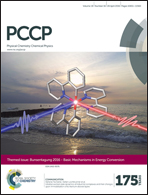Novel nanorose-like Ce(iii)-doped and undoped Cu(ii)–biphenyl-4,4-dicarboxylic acid (Cu(ii)–BPDCA) MOSs as visible light photocatalysts: synthesis, characterization, photodegradation of toxic dyes and optimization
Abstract
A novel nanorose-like metal organic system (MOS) based on Cu(II) and biphenyl-4,4-dicarboxylic acid (Cu–BPDCA) was hydrothermally synthesized and characterized via EDS, FE-SEM, XRD, DRS and FT-IR analysis. This novel nanomaterial was found to be of narrow energy band gap (1.24 eV) and thus it was applied as a photocatalyst driven by visible light for the degradation of the rose bengal (RB) and eosin Y (EY) dyes. For further improvement in the photocatalytic performance of Cu–BPDCA, it was doped with a trace amount of Ce(III) in a simple way followed by characterization. The achieved improvement is due to the formation of a large number of O2−˙ and ˙OH radicals compared to the case of undoped Cu–BPDCA. The influence of important variables such as initial dye concentration, photocatalyst dosage and time of irradiation on the photocatalytic degradation efficiency was studied and optimized using central composite design. The optimum condition for the photodegradation of RB was found to be 40 min, 4.0 mg L−1 and 0.015 g, corresponding to the irradiation time, RB concentration and photocatalyst mass, respectively. The photodegradation of EY was optimized at 4.0, 76 min, 5.9 mg L−1 and 0.015 g corresponding to the pH, irradiation time, EY concentration and photocatalyst mass, respectively. At these optimum conditions, the photocatalytic degradation percentages of RB and EY with a desirability of 0.95 and 1.0 were found to be 78.90% and 67.63%, respectively. Kinetics study showed that the Langmuir–Hinshelwood kinetics model suitably fits the experimental data. From the Langmuir–Hinshelwood kinetics model, a significantly high photodegradation to surface adsorption ratio was obtained which is the great advantage of this work in addition to applying visible light.


 Please wait while we load your content...
Please wait while we load your content...